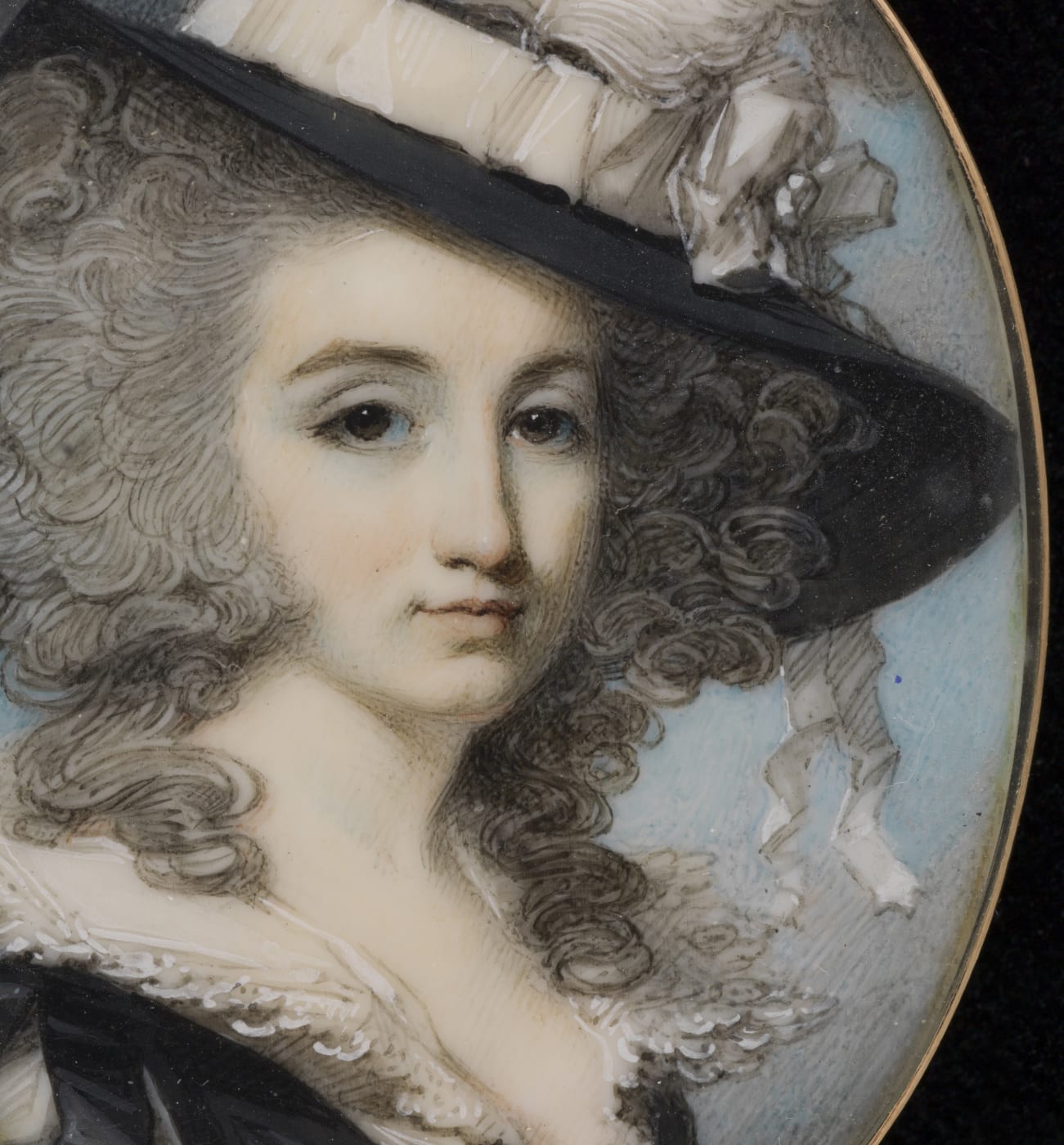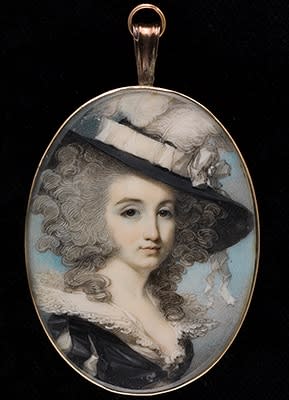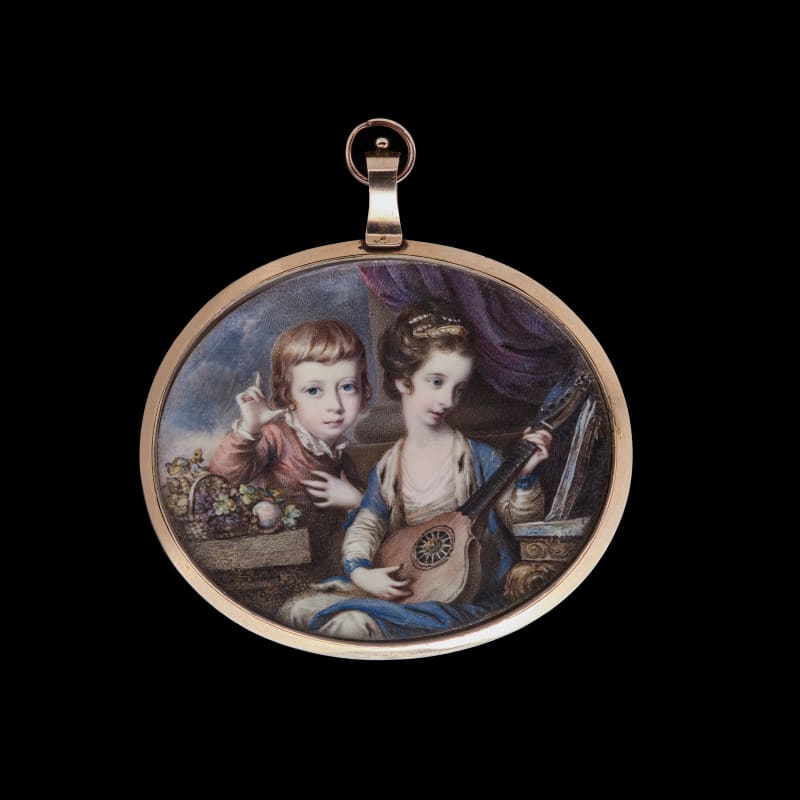Full Biography
George Engleheart ranks alongside John Smart, Richard Cosway and Ozias Humphry as one of the most talented portrait[1] miniaturists active in Georgian England. The third surviving son of a German plaster modeller, Francis Engleheart, George was born at Kew in London. His inextinguishable creative ambition manifested at an especially young age and his drive and spirit served him well in carving a successful career as a highly productive and accomplished miniaturist.
Engleheart began his professional training in 1769 when he was admitted into the Royal Academy Schools in London, starting as a pupil of the Irish landscape artist George Barret. Perhaps owing to Barret’s bankruptcy, Engleheart found himself under the supervision of the celebrated portrait painter Sir Joshua Reynolds from 1773 until 1776. He meticulously studied Reynolds’s creative approach, carefully copying his full-scale oil paintings in miniature, observing his master’s technique, style and compositional devices which would later emerge in Engleheart’s subsequent work.
George Engleheart ranks alongside John Smart, Richard Cosway and Ozias Humphry as one of the most talented portrait[1] miniaturists active in Georgian England. The third surviving son of a German plaster modeller, Francis Engleheart, George was born at Kew in London. His inextinguishable creative ambition manifested at an especially young age and his drive and spirit served him well in carving a successful career as a highly productive and accomplished miniaturist.
Engleheart began his professional training in 1769 when he was admitted into the Royal Academy Schools in London, starting as a pupil of the Irish landscape artist George Barret. Perhaps owing to Barret’s bankruptcy, Engleheart found himself under the supervision of the celebrated portrait painter Sir Joshua Reynolds from 1773 until 1776. He meticulously studied Reynolds’s creative approach, carefully copying his full-scale oil paintings in miniature, observing his master’s technique, style and compositional devices which would later emerge in Engleheart’s subsequent work.
On completion of this apprenticeship, Engleheart established his own practice initially being based on Shepherd Street, Mayfair, then moving to a studio on Princes Street, near Hanover Square in 1776, and finally settling at 4 Hertford Street in 1783. He quickly attracted an impressive client base for his regency[2] portrait miniatures, with rapid success undoubtedly bolstered by his association with Reynolds, and became a central figure in a thriving market for watercolours on ivory. According to his fee-book, now in private ownership, Engleheart produced over four thousand eight hundred portrait miniatures throughout his forty-year career, demonstrating the huge demand for his work among notable members of London’s elite. His clients appreciated the characteristic poise and sobriety evidenced in his portraiture and valued his keen observation to detail and excellent draughtsmanship.
From 1773 to 1822, Engleheart exhibited a selection of his miniatures from a growing portfolio at the Royal Academy. His early miniatures (c.1773–1780) are smaller in scale, for example A Young Girl, wearing white dress, with more muted tones in comparison with his more confident handling and fluent brushwork evident in his middle period between c.1780 to 1795, A Lady Wearing a White Dress. From around 1795 onwards, characteristics included larger, deeper eyes, linear handling of hair, cool flesh tones and an emphasis on costume through the use of flashes of opaque white. Examples of this[3] differing style are found in our artworks section below, where various notable George Engleheart sales, and available miniatures are listed. In his mature period Engleheart preferred painting on larger ivories and began to abandon his customary oval shape in favour of rectangular ivories, taking on a subdued palette for the features and a generally more honest approach in capturing the character of his subjects.
The skill and virtuosity apparent in his work enlisted the patronage of military men like Lieutenant-Colonel George Collier, aristocratic intelligentsia, society sweethearts and even King George III, who in 1789 employed Engleheart as his Pictor Primus[4] , producing around twenty five portraits of the monarch and other members of the royal family. His decorative style and skill in flattery favoured the royal aesthetic and in return for his favour King George helped to raise the artist’s reputation. Such regal associations induced even more commissions and high demand for his portrait miniatures[5] , but Engleheart worked rapidly, painting straight from life without preliminary sketches, allowing him to meet this growing demand.
In 1776, Engleheart married Elizabeth Brown, who sadly died only three years later, after which he married her sister Ursula Sarah Brown in 1781; the pair had four children named George, Nathaniel, Henry and Emma. The Englehearts divided their time between Hertford Street and their country seat at Bedfont, Middlesex. In July 1813 Engleheart retired to paint only portraits of family, friends, artists and poets, including William Hayley, George Romney, William Blake, John Flaxman and Jeremiah Meyer. In 1827 he moved to Blackheath, Kent, joining his son Nathaniel, where he finally died on 21 March 1829 and was buried in the family vault at Kew church.
Philip Mould & Company have acquired, sold and bought various artworks by Engleheart over the past 30 years. One significant sale listed above, includes A Portrait Miniature of Elizabeth Juliana Monro wearing black dress with sleeves slashed to reveal white.












